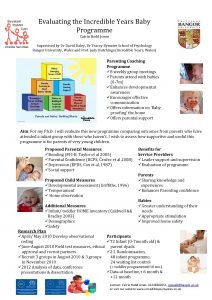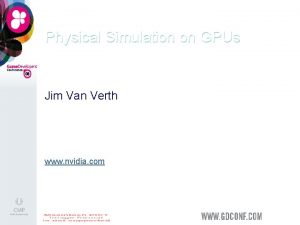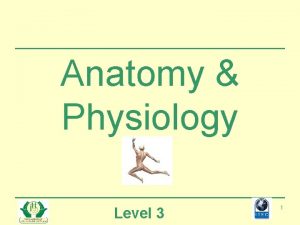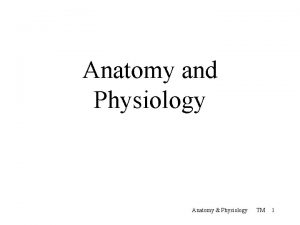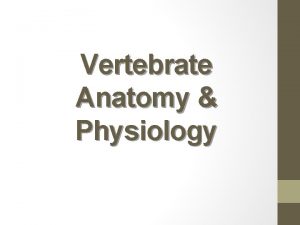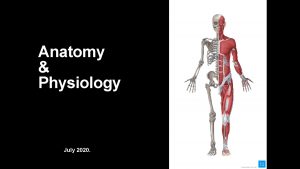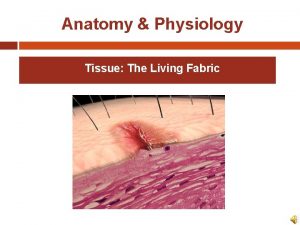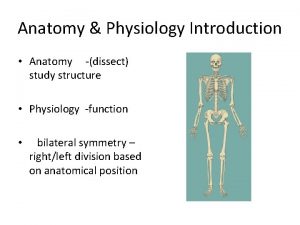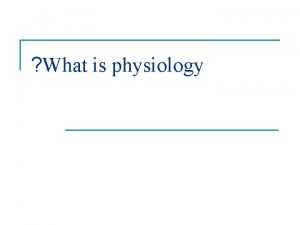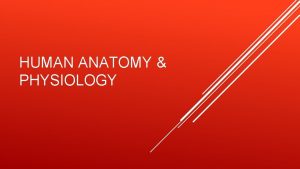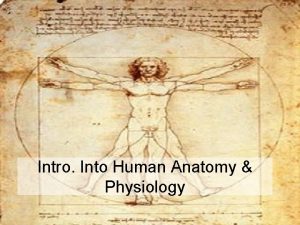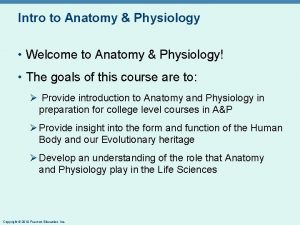Chapter 6 Anatomy and Physiology Caroline Daley Chapter









































- Slides: 41

Chapter 6: Anatomy and Physiology Caroline Daley

Chapter Goals · General terminology - specifically those used often in medical communication · Five body cavities and what they contain · 11 body systems and how they work · Highlight connections and processes instead of locations

Planes and Directional Terms Sagittal Plane (Median Plane) Coronal Plane (Frontal Plane) Transverse Plane (Horizontal Plane) See page 168, figure 6 -2 in OEC textbook.

Planes and Directional Terms cont. Anterior (front of body) Posterior (back of body) Superior (near patient’s head) Inferior (near patient’s feet) Medial (near patient’s midline) Lateral (far from patient’s midline) Internal (inside of body) External (outside of body) See page 169, figure 6 -3 in OEC textbook.

Planes and Directional Terms cont. Proximal (close to “trunk” of body) Distal (far from “trunk and closer to extremities) Superficial (near surface of body) Deep (far from surface of body) Right Left

Terms for Motion Flexion (bending or flexing movement) → E. g. Bending knee or making a fist Extension (straightening movement) → E. g. Straightening arm With prefix hyper - → Movement beyond normal range of motion Abduction (moving extremity away from midline) Adduction (moving extremity toward the midline)

Terms of Position Normal anatomical position (standing erect, arms at sides, palms forward) Supine (flat on back, face up) Prone (flat on stomach, face to the side) Right or left lateral recumbent position / Recovery position (lying on side)

Terms of Position cont. Semi-Fowler position (lying on back with upper body elevated at 45 to 60 degree angle) High fowler position (lying on back with upper body elevated at 90 degree angle at the waist) Trendelenburg position (lying on back, forming an inclined plane with feet elevated above head)

Body Cavities Cranial cavity (inside skull, contains brain and membranes that surround it) Spinal cavity (canal formed by vertebrae extending from bottom of skull to tailbone, contains spinal cord and membranes that surround it) Thoracic (chest) cavity (“trunk” of body between diaphragm and neck, contains lungs heart, and great vessels, protected by rib cage, sternum, and upper spine)

Body Cavities cont. Abdominal cavity (“trunk” of body between diaphragm and pelvis, contains liver, gallbladder, pancreas, stomach, intestines, spleen, divided into four quadrants) Pelvic cavity (inferior to abdominal cavity, contains bladder, rectum, and internal reproductive organs, protected by pelvic bones and lower spine)

Body Cavities cont.

Body Systems Respiratory system Integumentary system Cardiovascular system Skeletal system Nervous system Muscular system Gastrointestinal system Reproductive system Urinary system Lymphatic system Endocrine system

Respiratory System of organs and structures that draw oxygen into the body and eliminate carbon dioxide through respiration

Upper Respiratory System Consists of nose, mouth and teeth, tongue and jaw, pharynx, larynx, and epiglottis Mouth and nose moisten air before it enters the body Epiglottis prevents foreign objects from entering airway

Lower Respiratory System Consists of trachea, bronchi, and lungs which contain bronchioles and alveoli Alveoli are the site of exchange of carbon dioxide and oxygen between air and blood Diaphragm contracts, lungs expands due to negative pressure in thoracic cavity → Inspiration Diaphragm relaxes, lungs recoil → Expiration

Cardiovascular System Consists of heart, blood vessels, and blood Delivers oxygen, nutrients, and fluids to body’s cells Delivers carbon dioxide and other waste to lungs and kidneys for excretion

Structure of the Heart Right side of heart → Deoxygenated blood to the lungs Superior vena cava Left side of heart → Oxygenated blood to the body Arteries → Blood away from heart Veins → Blood toward heart Capillaries → Exchange site between blood and tissue Inferior vena cava

Blood Flow Systolic pressure (left ventricle contracts) Diastolic pressure (left ventricle is at rest) Measured in mm and written as systolic pressure over diastolic pressure (e. g. 120/80 mm) Affected by dilation of arteries and cardiac output

Blood Red blood cells (carry to body and remove carbon dioxide from it) White blood cells (defend against infection) Platelets (forms blood clots to stop loss of blood during hemorrhaging) Plasma (liquid portion that carries blood and nutrients to tissues

Nervous System Control over all other body systems -function fo sensation, regulates motor system, integrates consciousness, memory, emotions and language Central nervous system Peripheral nervous system

The Brain Cerebrum (memory, thought, voluntary muscle use) Cerebellum (constant involuntary functions e. g. coordinated movement) Spinal cord (vital functions e. g. respiration, cardiac function)

More Anatomy Vocabulary Meninges (collective title for three protective layers of brain and spinal column) Cerebrospinal fluid (clear colorless fluid produced in brain that circulates through central nervous system) Buoyancy, cushioning/protection, chemical stability Voluntary system (controls muscle movement and sensation from sensory organs to brain and spinal cord) Autonomic system (involuntary control of muscles of organs and glands Sympathetic (response to stressors like pain or fear or blood loss) Parasympathetic (opposite of sympathetic)

Gastrointestinal System Process food, absorb nutrients, and eliminate indigestible in abdominal cavity Salivary glands (produces saliva) Oral cavity (ingests, chews, swallows food) Esophagus (transports food to stomach) Stomach (secretes acid and mixes food to start digestion

Gastrointestinal System cont Liver (digestion of fat by bile production and toxin break down site) Gallbladder (stores bile) Small intestine (digests and absorbs nutrients) Colon (reabsorbs water and stores feces) Chemical vs. mechanical digestion

Urinary System Purpose: Remove wastes and toxins from the blood and excrete them in urine. Kidneys: produce urine by filtering metabolic wastes from circulating blood. Also regulate water balance in the body, maintaining the balance of electrolytes and controlling blood p. H. Ureters: duct by which urine passes from kidneys to bladder Urinary bladder: stores urine, sits on pelvic floor Urethra: tube for excretion of urine (and semen, for men)

Endocrine System Purpose: produce chemical substances that act as messages throughout the body Anatomy of the Endocrine System: Hypothalamus: secretes hormones that act on the pituitary gland, also controls regulation of water excretion by kidneys Pituitary gland (AKA “master gland”): secretes chemicals that regulate growth and the activities of many other glands Thyroid gland: regulates metabolism, growth, and development. Also partially regulates nervous system activity Adrenal glands: located on top of kidneys, secrete several hormones, including epinephrine(adrenalin) and norepinephrine (noradrenaline) which function in the “fight-orflight” response

Endocrine System Anatomy, cont. : Pancreas: located in the middle of the abdomen, has both endocrine function (secretes hormotes that regulate blood glucose) and non-endocrine functions. Gonads (ovaries & testes): produce hormones that control reproduction and sex characteristics Pineal gland: tiny gland in the brain that helps regulate daily wake/sleep patterns (circadian rhythm)

Endocrine System Critical Functions of the Endocrine System: Control of blood glucose levels: ● Pancreas produces and secretes insulin, which lowers the level of glucose in the ody and permits cells to use glucose. ● Pancreas also releases glucagon, which raises the level of glucose in the body by facilitating the conversion of stored carbohydrates to glucose. Regulation of sympathetic nervous system: ● Adrenaline and noradrenaline (produced by adrenal glands) cause multiple effects on the sympathetic system, including constriction of vessels, increased heart rate, and dilation of smooth muscles, including those that control respirations and the size of the bronchi

Integumentary System Protects body, retain fluids, prevent infection Superficial epidermis (skin’s pigmentation) Dermis (blood vessels, nerves, glands, hair, elasticity and strength) Hair (provides some protection and associated with sensory receptors) Nail (covers and protects tips of digits)

Skeletal System Support the body, provide attachment points for muscles, protect internal organs, allow movement, store minerals, site of blood production Ligament (joins bone to bone) Long bones → arms and legs Flat bones → skull and pelvis

Types of Joints Ball and socket → hip Condyloid → finger Gliding → shoulder Hinge → elbow Pivot → cervical spine Saddle → base of thumb

Segments of Skeletal System Skull → cranium and face Spinal column → spinal column; vertebrae Thorax → ribs, sternum, thoracic spine Pelvis → ilium, pubis, ischium Upper extremities → shoulders, arms and hands Lower extremities → hips, legs and feet

Bones of the Skull

Muscular System Purpose: allow movement of the body, movement within the organs of the digestive system, and the beating of the heart. The body has over 600 muscles, attached to bones by tendons that increase mechanical advantage. 3 Types of Muscles: 1. Skeletal (voluntary) Muscle: under control of voluntary nervous system. Help give the body its shape and make it possible to move when we walk, smile, talk, etc. 2. Smooth (involuntary) Muscle: found in the walls of tubelike organs, ducts, and blood vessels. Also form much of intestinal wall. 3. Cardiac Muscle: found only in the walls of the heart. Has unique property of being able to generate its own electrical impulses independent of the nervous system. Primary purpose of cardiac muscle is to produce the pumping action of the heart

Muscular System Physiology of the Muscular System: Contraction of a skeletal muscle results in movement of bones. ➔ Muscles are typically paired so that one set of muscles produces flexion of a joint, and a different set produces extension of a joint Contraction of smooth muscles leads to movement within the organs of the body. ➔ Smooth muscle inside the wall of the intestines moves the food being digested along the gastrointestinal tract toward the anus. Contraction of cardiac muscle causes the pumping action of the heart that moves blood through the cardiovascular system.

Reproductive System

Male Reproductive System Testes (produces sperm and secretes testosterone) Epididymis (stores sperm) Vas deferens (transports sperm to urethra) Prostate gland seminal vesicles (secretes fluid for semen)

Female Reproductive System Fallopian tube (transports ovum to uterus) Vagina (receives semen during intercourse; birth canal) Uterus (site of development of fetus) Ovary (produces ova and secretes estrogen and progesterone)

Lymphatic System Returns interstitial fluid from around cells to bloodstream, transports particulate materials, absorbs fats, produces lymphocytes (white blood cells) Thymus (necessary for development of immune system) Tonsil (protects against pathogens in pharynx)

Lymphatic System cont. Lymph node (cleanses lymph fluid) Spleen (cleanses blood and removes old red blood cells) Lymphatic vessel (transports lymph fluid)

Homeostasis Process by which an organism maintains a stable internal environment by adjusting its physiological processes All 11 interact Example: integumentary and cardiovascular maintain steady blood pressure
 Professor david daley
Professor david daley Jimmy daley nvidia
Jimmy daley nvidia Chapter 14 anatomy and physiology
Chapter 14 anatomy and physiology Waistline
Waistline Anatomy and physiology chapter 8 special senses
Anatomy and physiology chapter 8 special senses Chapter 13 anatomy and physiology of pregnancy
Chapter 13 anatomy and physiology of pregnancy Chapter 2 basic chemistry anatomy and physiology
Chapter 2 basic chemistry anatomy and physiology Heat and cold
Heat and cold Chapter 14 the digestive system and body metabolism
Chapter 14 the digestive system and body metabolism Chapter 10 blood anatomy and physiology
Chapter 10 blood anatomy and physiology Anatomy and physiology chapter 15
Anatomy and physiology chapter 15 Necessary life functions anatomy and physiology
Necessary life functions anatomy and physiology Holes anatomy and physiology chapter 1
Holes anatomy and physiology chapter 1 Gi tract histology
Gi tract histology Chapter 1 introduction to human anatomy and physiology
Chapter 1 introduction to human anatomy and physiology Chapter 2 human reproductive anatomy and physiology
Chapter 2 human reproductive anatomy and physiology Male vs female skeleton pelvis
Male vs female skeleton pelvis Chapter 6 general anatomy and physiology
Chapter 6 general anatomy and physiology Anterior posterior ventral dorsal
Anterior posterior ventral dorsal Upper respiratory system
Upper respiratory system Tattoo anatomy and physiology
Tattoo anatomy and physiology Science olympiad anatomy and physiology
Science olympiad anatomy and physiology Specialized stems examples
Specialized stems examples Bone anatomy and physiology
Bone anatomy and physiology Duodenal ulcer anatomy
Duodenal ulcer anatomy Liver anatomy and physiology
Liver anatomy and physiology Epigastric region
Epigastric region Epigastric vs hypogastric
Epigastric vs hypogastric Google.com
Google.com 3 layers of muscle
3 layers of muscle Http://anatomy and physiology
Http://anatomy and physiology Physiology of appendix
Physiology of appendix Aohs foundations of anatomy and physiology 1
Aohs foundations of anatomy and physiology 1 Aohs foundations of anatomy and physiology 1
Aohs foundations of anatomy and physiology 1 Anatomical planes
Anatomical planes Unit 26 animal anatomy physiology and nutrition
Unit 26 animal anatomy physiology and nutrition Science olympiad forensics cheat sheet
Science olympiad forensics cheat sheet Physiology of stomach ppt
Physiology of stomach ppt Anatomy and physiology of pancreas
Anatomy and physiology of pancreas Aohs foundations of anatomy and physiology 1
Aohs foundations of anatomy and physiology 1 Aohs foundations of anatomy and physiology 1
Aohs foundations of anatomy and physiology 1 Anatomy and physiology
Anatomy and physiology
